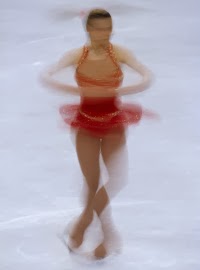Watching the Olympics, I have seen a commercial that annoys me. It features a figure skater comparing what she goes through to other occupations. One is that she "experiences more g-forces than a fighter pilot". Let's examine that claim.
The math
The forces on the various parts of a spinning skater are due to rotation. However, we will look at the acceleration since that what g-forces really are. For a 5g-force, the relationship between rotation speed (RPM) and distance from rotation center (r) is
A graph might make this equation a little more meaningful.
So, we can see that a 5-g force can be obtained for a hand rotating 1 meter from the center at a little more that 60 rpm (or one rotation each second). But the head? Even with a skater's head held straight out at around 20 cm, 5-g's would only be experienced at 150 rpm (over 2 rotations per second). And if we look at a 9-g force which most fighter pilots experience occasionally (and for a lot more than a second), it would take 200 rpm. While the supposed world record for a figure skater spin is around 300 rpm, that skater held her head upright, so her nose might feel a 9-g force, her head would feel a much lower force.


.gif)

While I find your post incredibly enlightening I believe that you have over looked an incredibly important fact.the fastest spin, "the scratch spin" rotates at about 240-300 rpms on average. With regard to the comment "when was the last time you saw a skater do a rapid spin in competition." 3 things to consider...ice dancers do not do scratch spins, pair skaters do not do them always, singles skaters however, not only do them frequently, but are required to do them. You can expect to see at least one scratch spin per program. Many long programs have 4 spins, most of will finish with either a forward or backwards scratch spin. Watch the ladies long program on 2/20/2014 and you'll see what I mean. I am impressed with your knowledge of physics. Hopefully you will soon be impressed with how fast the "rapid spins" are, and just how often they are performed,
ReplyDeleteYou have also not accounted for jumping. There are plenty of extremely fast spins performed in competition on a regular basis. The world record holder you are referring to is probably Lucinda Ruh and she actually has physical symptoms that have resulted from her years of spinning so fast. The spins do put a lot of force on various parts of your body. I can remember when I was skating and as you go into a scratch spin you can feel the force on your leg and arms as you pull them in and it is hard to overcome and hold it all in as your spin speed increases. There are a lot of great spinners in the ladies competition at the Olympics. Feel free to watch and you will see a lot of really fast spins. Also, the men do quad jumps. That's 4 rotations in a fraction of a second. What's the math on that?
ReplyDeleteMy point in this blog is that while skaters may experience 5+g forces on some parts of their bodies (not their heads) for about a second, it is disingenuous to try to compare those forces to those experienced by fighter pilots who feel those forces over their entire bodies and for a lot longer time. I do not dispute that figure skaters feel forces on parts of their bodies comparable to other athletes, but to imply that those forces are felt over a long time and over the entire body is misleading.
ReplyDeleteCritical difference is that the fighter pilot is wearing a G-suit, designed to reduce the "felt" G forces dramatically...whereas the skater has no such benefit. Moreover, competitive figure skaters develop a higher tolerance for G-forces than fighter pilots because they undergo G-force loads over and over on a daily basis, in contrast, even the most active fighter pilots don't fly anywhere close to daily (outside of short-term training schools).
ReplyDelete